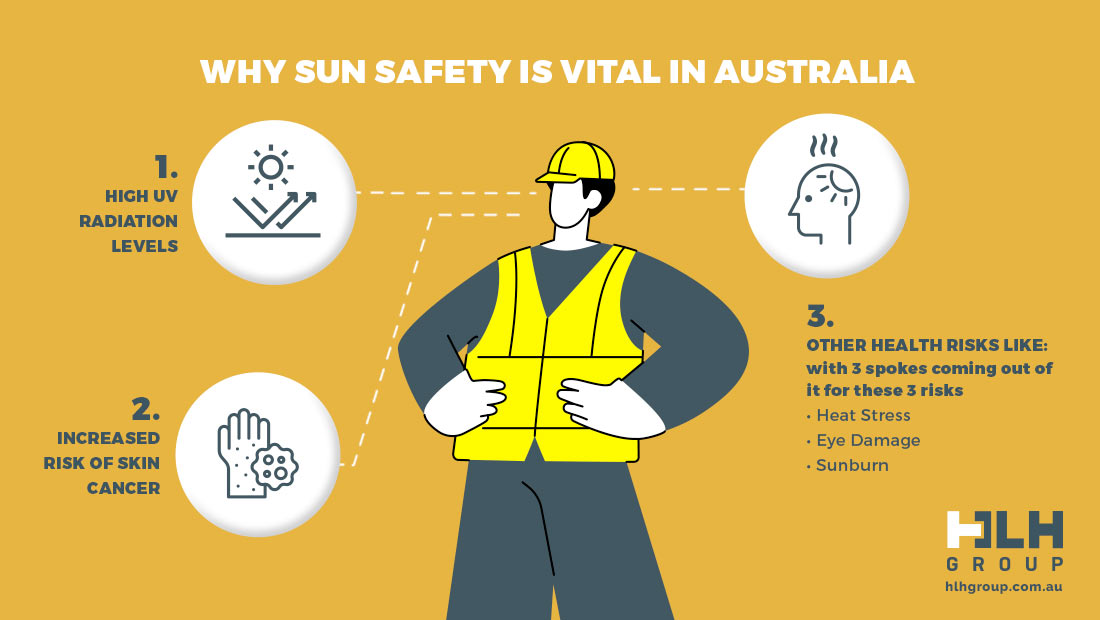
17 Sep Sun Safety for Outdoor Workers in Australia: Why It’s Essential
Australia is known for its sunny climate and stunning outdoor scenery, but with great sunshine comes great responsibility — especially for those who work outdoors like labourer hire. Whether you’re in construction, agriculture, landscaping, or any other profession that requires spending long hours under the sun, sun safety should be a top priority. Prolonged exposure to the sun’s ultraviolet (UV) rays not only increases the risk of skin cancer but can also lead to other health complications. In a country with some of the highest UV radiation levels in the world, understanding and practicing sun safety is crucial.

Why Sun Safety is Vital in Australia
1. High UV Radiation Levels
Australia’s proximity to the equator means it experiences some of the highest UV radiation levels globally. UV rays are invisible but can penetrate the skin, causing damage to skin cells. Over time, this damage can lead to skin cancer, premature aging, and other health issues. UV radiation is especially intense in the summer months, but it can still cause harm during cooler months or on cloudy days.
2. Increased Risk of Skin Cancer
Australia has one of the highest rates of skin cancer in the world, with outdoor workers being particularly vulnerable. Melanoma, the most dangerous form of skin cancer, is more prevalent in Australia due to the high exposure to UV radiation. The Australian government estimates that two in three Australians will be diagnosed with skin cancer by the age of 70. For outdoor workers, who often spend hours exposed to direct sunlight, the risks are compounded. Taking steps to protect your skin isn’t just about comfort – it’s about significantly reducing your chances of developing skin cancer later in life.
3. Other Health Risks
Beyond skin cancer, prolonged sun exposure can lead to a range of other health issues, including:
- Heat Stress: Excessive heat can lead to dehydration, heat exhaustion, and heat stroke, which can be dangerous if not treated promptly.
- Eye Damage: UV rays can also harm your eyes, leading to cataracts and other forms of eye damage if proper protection isn’t worn.
- Sunburn: While often seen as a minor issue, repeated sunburns can cause permanent skin damage and increase cancer risk over time.
Sun Safety Strategies for Outdoor Workers
Implementing sun safety measures in your daily routine can make a huge difference in protecting your health. Here are some essential tips:
- Wear Sun-Protective Clothing: As part of the summer PPE Long-sleeved shirts, long pants, and wide-brimmed hats made from tightly woven fabric can help protect your skin from UV radiation. Look for clothing with a high ultraviolet protection factor (UPF) rating, which indicates how much UV radiation the fabric can block.
- Use Sunscreen: Sunscreen is a vital part of sun safety. Choose a broad-spectrum sunscreen with an SPF of 30 or higher, and apply it to all exposed skin 20 minutes before heading outdoors. Reapply every two hours, or more frequently if you’re sweating or working in water. Don’t forget often-missed spots like your ears, neck, and the back of your hands.
- Seek Shade: Whenever possible, take breaks in shaded areas. Working in direct sunlight for extended periods without any shade can significantly increase your risk of UV exposure and heat-related illnesses. Portable shelters, trees, or shaded workstations can provide a safe spot for breaks.
- Wear Sunglasses: Choose sunglasses that provide 100% UV protection to shield your eyes from harmful rays. Wrap-around sunglasses are especially effective, as they protect your eyes from UV rays that can come from different angles.
- Stay Hydrated: Working outdoors in the sun can lead to rapid dehydration. Drink plenty of water throughout the day to stay hydrated and help regulate your body temperature. Avoid sugary drinks or caffeine, as they can contribute to dehydration.
- Monitor the UV Index: The UV index is a tool that measures the intensity of UV radiation. In Australia, the UV index is regularly reported in weather forecasts. If the index is 3 or higher, sun protection is needed. Plan your workday around the UV index when possible schedule outdoor tasks during early morning or late afternoon when UV levels are lower.

Employers’ Role in Sun Safety
Employers, especially labour hire companies, have a responsibility to ensure the safety of their workers, and this includes protecting them from the harmful effects of the sun. In Australia, occupational health and safety regulations require employers to provide appropriate sun protection measures for outdoor workers. This can include:
- Providing training on the importance of sun safety
- Supplying sunscreen, protective clothing, and sunglasses
- Scheduling work during lower UV times when possible
- Encouraging regular breaks in shaded areas
Sun Safety – A Workplace Priority
Working outdoors in Australia means facing unique challenges when it comes to sun safety. With skin cancer rates on the rise and high levels of UV radiation, outdoor workers are at an elevated risk of health problems related to sun exposure. By following simple, practical sun protection strategies — like wearing protective clothing, applying sunscreen, seeking shade, and staying hydrated—you can greatly reduce these risks and protect your long-term health.
Sun safety isn’t just a personal responsibility; it’s a workplace priority. Both workers and employers must work together to create a safe and sun-smart environment for everyone. Remember: the sun may be a powerful force, but with the right precautions, you can work under it safely.




No Comments